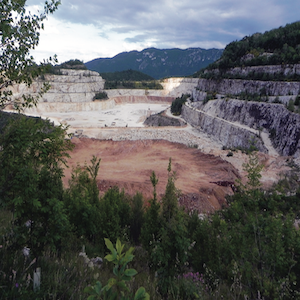Spontaneous renaturalization of open ecosystems in the hills of Brescia seen through the bird community

Accepted: 17 May 2023
All claims expressed in this article are solely those of the authors and do not necessarily represent those of their affiliated organizations, or those of the publisher, the editors and the reviewers. Any product that may be evaluated in this article or claim that may be made by its manufacturer is not guaranteed or endorsed by the publisher.
Authors
The sun-exposed open areas of the Brescia hills overlooking the Po Valley (Avanalpica region) were created by man starting from the 11th century. After the Second World War, following agro-pastoral abandonment, these areas have significantly shrunk. The evolution underway is towards the deciduous forest although in some areas the strong presence of quarries is blocking the vegetational succession or delaying it. Local birds are now largely associated with woodland coenosis and more scarcely with open areas, shrublands and wood edges. Seven open areas species have become extinct over the past 30 years: Woodchat Shrike, Barred Warbler, Rufous-tailed Rock-Thrush, Eastern Black-eared Wheatear, Tawny Pipit, Corn Bunting and Ortolan Bunting. Others, like Red-backed Shrike, Common Whitethroat, Cirl Bunting and Wood Lark have declined. Only the generalist Sardinian Warbler and Blue Rock-Thrush, typical of rocky areas with grassy spaces, are still relatively widespread although slightly decreasing. The Cirl Bunting, a species linked to traditional vineyards and orchards, is not expanding in the new intensively cultivated lands. The Eastern Subalpine Warbler is on the rise even though, due to its very low presence and lack of specific surveys, it may not have been detected in the past. The factors determining the presence of these species, i.e. traditional crops, flat open areas, soils with low grass and often with outcropping and/or rocky substrate, are in sharp decline. We can state that this bird community is negatively influenced by the percentage of tree cover and positively influenced by the presence of quarries which, however, represent an ephemeral and strongly impacting environment. In the absence of fires and/or natural disasters as well as human interventions, which are not likely to occur due to their poor economic sustainability, the prognosis for these birds is to be considered poor and a reduction in both bird and general biodiversity is to be expected.
Downloads
Citations
PlumX Metrics
PlumX Metrics provide insights into the ways people interact with individual pieces of research output (articles, conference proceedings, book chapters, and many more) in the online environment. Collectively known as PlumX Metrics, these metrics are divided into five categories to help make sense of the huge amounts of data involved and to enable analysis by comparing like with like.
How to Cite

This work is licensed under a Creative Commons Attribution-NonCommercial 4.0 International License.
PAGEPress has chosen to apply the Creative Commons Attribution NonCommercial 4.0 International License (CC BY-NC 4.0) to all manuscripts to be published.
Similar Articles
- Francesco Santilli, Silvio Azara, Lorenzo Galardi, Luca Gorreri, Antonio Perfetti, Marco Bagliacca, Evaluation of an aerial scaring device for birds damage prevention to agricultural crops , Rivista Italiana di Ornitologia: Vol. 82 No. 1-2 (2012)
- Davide De Rosa, Ilaria Fozzi, Alberto Fozzi, Mauro Sanna, Jan Škrábal, Rainer Raab, Benedetta Catiti, Andrea Rotta, Ivan Literák , Fiammetta Berlinguer, Mauro Aresu, A vanishing raptor in a Mediterranean island: an updated picture of Red kite (Milvus milvus) in Sardinia, Italy , Rivista Italiana di Ornitologia: Vol. 91 No. 1 (2021)
- Paolo Giacchini, Atlas of birds in the Province of Ancona , Rivista Italiana di Ornitologia: Vol. 82 No. 1-2 (2012)
- Silvio Colaone, Beniamino Fanchin, Abramo Giusto, Walter Guenzani, Fabio Saporetti, Tonino Zarbo, Playback census of a breeding population of Little Owl, Athene noctua, in NW Lombardy (Varese province). , Rivista Italiana di Ornitologia: Vol. 80 No. 2 (2010)
- Giuseppe Rannisi, Loredana Murabito, Marco Gustin, Bruno Massa, Impact of predation by the black rat, rattus rattus, on the breeding success of cory’s shearwater, Calonectris diomedea, on Linosa island (Sicily, Italy) , Rivista Italiana di Ornitologia: Vol. 82 No. 1-2 (2012)
- Pierandrea Brichetti, Nunzio Grattini, Distribution and population trend of the Reed Bunting, Emberiza schoeniclus, breeding in Italy in the years 1980-2010. , Rivista Italiana di Ornitologia: Vol. 81 No. 2 (2011)
- Cinzia Ciarmatori, Pierfrancesco Gambelli, David Belfiori, The Wildlife Rescue Centre Ripabianca di Jesi (Ancona), data: 2005-2007 , Rivista Italiana di Ornitologia: Vol. 82 No. 1-2 (2012)
- Francesco Velatta, Mario Muzzatti, Monica Montefameglio, Maria Maddalena Chiappini, Monitoring of some species of colonial nesting Ardeidae at Lake Trasimeno (Central Italy). , Rivista Italiana di Ornitologia: Vol. 80 No. 2 (2010)
- Fabrizio Bulgarini, Fulvio Fraticelli, The European laurel Laurus nobilis berries in the diet of the blackbird Turdus merula , Rivista Italiana di Ornitologia: Vol. 93 No. 2 (2023)
- Andrea Simoncini, Daniela Papi, Enrico Ruggeri, Birds of the Entella river (Genoa, Italy): a qualitative assessment of bird diversity in an urbanizing biotope, with implications for management and conservation , Rivista Italiana di Ornitologia: Vol. 88 No. 2 (2018)
<< < 1 2 3 4 5 6 7 8 9 10 > >>
You may also start an advanced similarity search for this article.


 https://doi.org/10.4081/rio.2023.667
https://doi.org/10.4081/rio.2023.667



